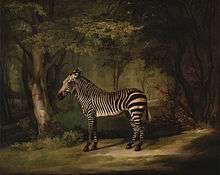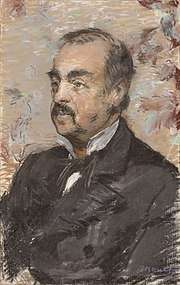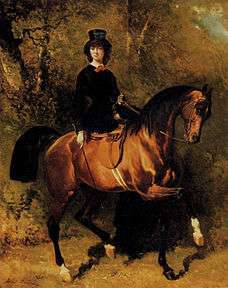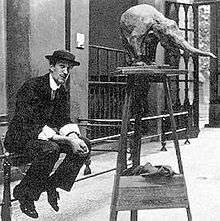Animalier school
Animalier school or animalier[1][2][3] movement was a roughly late 18th century to late 19th century movement and school of art, which took as its subject in various figurative forms the animal kingdom or Kingdom Animalia. The movement predominantly centered around Paris, France, and Italy, with some offshoots in England, Germany, and North America.


Some examples of animalier artists and their subjects are George Stubbs and Jules Moigniez (paintings and sculpture of horses), Antoine-Louis Barye (sculpture of bulls and humans), and Rembrandt Bugatti (felines, human figures, and zoo animals).
History

Animals as a visual motif were used in ancient art and in tribal art, in animal style art and objects but were not generally represented as figurative, anatomically correct, creatures.[4] The Celtic-Germanic animal style with its "combination of abstract and organic shapes, of formal discipline and imaginative freedom, became an important element ... in the art of the Dark Ages."[5] During the Baroque period in France and England, a 1670 commissioned terracotta model for a sculpture of Louis XIV titled Equestrian Statue of Louis XIV by Gian Lorenzo Bernini was rejected on the grounds that it was not suitable to the dignity of the king.[6] The term animalier was first used by the French press and salon jurors, often as a derogatory term.[7] The Paris salon thought animal subjects too common for fine art, but with the opening of the new Paris Jardin des Plantes zoo and the Ménagerie du Jardin des plantes, interest in animal art increased.[8] The Dukes of Orleans, Luynes, Montpensier, and Nemours were soon to become Barye's patrons. In 1882 Edouard Manet created a portrait in pastel on canvas of the animalier artist Julien de La Rochenoire, which has been owned by the Getty Museum since 2014.[9]

The art of George Stubbs became a favorite of collector Paul Mellon, who donated many of Stubbs' paintings to the Yale Center for British Art.[10]
It has been observed that "many animal sculptures were modeled in plaster for exhibition and cast later in bronze editions. The size and variety of an edition depended on the popularity of the piece at exhibition, and many Barye, Mêne, and Fratin pieces were so popular that they were cast in very large editions."[11]


Animalier artists

Artists of the animalier movement were referred to as les animaliers. Important artists of the animalier movement included Antoine-Louis Barye (1796–1875), Rembrandt Bugatti (1884–1916), George Stubbs (1724–1806), Alfred Dedreux (1810–1860), Christopher Fratin (1801–1864),[12][13] Alexandre Guionnet, Pierre-Jules Mêne (1810–1879).[14] Rosa Bonheur (1822–1899), Isidore Bonheur (1827–1901), Anna Hyatt Huntington (1876–1973), Paul-Edouard Delabrierre (1829–1912), Alfred Dubucand (1828–1894), Jules Moigniez (1835–1894) and Émile-Coriolan Guillemin (1841–1907).
Animalier reproductions
Many beautiful replicas are made of animalier sculpture, which may be cast or molded in any size and of any material. The most desirable of these are exact in detail and made from the same material, such as cast iron, spelter, or cast bronze, as used in the artist's original sculpture. Most of the original animalier sculptors used the traditional lost wax process of casting prevalent at the time. Alexandre Guionnet[15] was exceptional in that he worked in wood. Modern reproductions of the original sculptures frequently use patinated verdigris cast bronze or iron, or bonded marble resin (pulverized reconstituted marble combined with resin glue), as well as various other materials and techniques, such as a composite of Capiz placuna placenta oyster shells, also known as window oyster shells, which come primarily from the Philippines (where they are known as kapiz).
References
- Kjellberg, Pierre (1994). Bronzes of the 19th Century. Atglen, Pennsylvania: Schiffer Publishing, Ltd. ISBN 0-88740-629-7.
- "Animalier". wiktionary.org. Retrieved October 29, 2016.
- Payne, Christopher (1986). Animals in Bronze -- Reference and Price Guide. Woodbridge, Suffolk, England: Antique Collectors' Club Ltd. ISBN 0-90746-245-6.
- Janson, H.W. (1986). History of art : a survey of the major visual arts from the dawn of history to the present day (3rd ed.). New York: H.N. Abrams. pp. 81–82. ISBN 0-8109-1094-2.
- Janson, H.W.; Janson, Anthony F. (1986). History of art : a survey of the major visual arts from the dawn of history to the present day (3rd ed.). New York: H.N. Abrams. pp. 255–256. ISBN 0-8109-1094-2.
- Janson, H.W. (1986). History of art: a survey of the major visual arts from the dawn of history to the present day (3rd ed.). New York: H.N. Abrams. pp. 553–554. ISBN 0-8109-1094-2.
- Gallery, The Bronze. "Les Animaliers - The 19th century French movement of Bronze Sculpture". bronze-gallery.com. Retrieved 21 October 2016.
- http://www.iub.edu/~iuam/online_modules/metz/collection.html
- http://www.getty.edu/art/collection/objects/265936/edouard-manet-portrait-of-julien-de-la-rochenoire-french-1882/
- Maj, Yale Center for British Art, Lec. "Zebra". collections.britishart.yale.edu. Retrieved 31 October 2016.
- "The Metz Collection". www.iub.edu. Retrieved 28 October 2016.
- http://www.bronze-gallery.com/sculptors/artist.cfm?sculptorID=21
- http://www.worldcat.org/title/concise-history-of-bronzes/oclc/15625
- http://www.artic.edu/aic/collections/artwork/artist/Mene%2C+Pierre-Jules
- "Auguste Cain. Expert art authentication, certificates of authenticity and expert art appraisals - Art Experts". www.artexpertswebsite.com. Retrieved 28 October 2016.